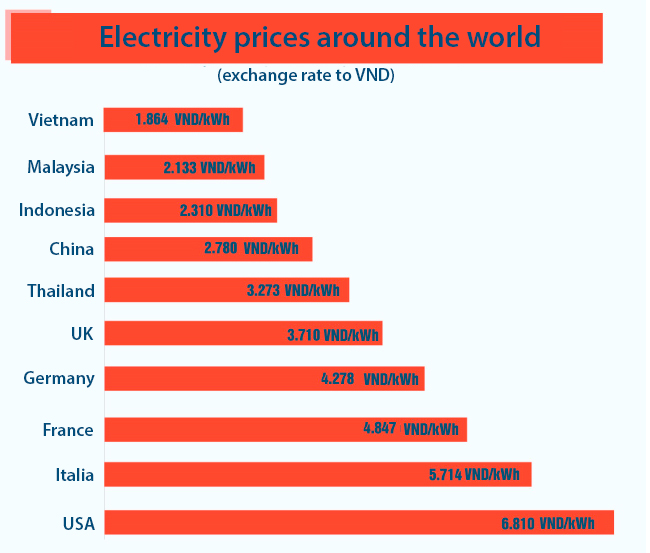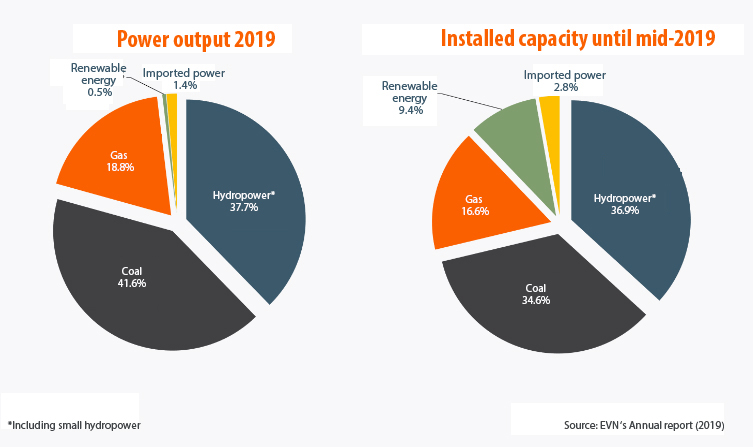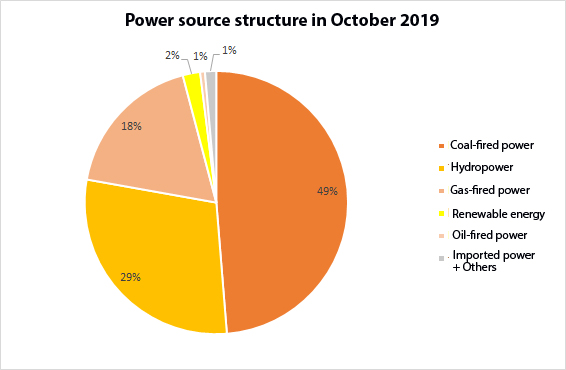|
Electricity prices mechanism in Vietnam
Electricity is a specific and very important commodity for the economy as well as people's daily life, so electricity prices information is always interesting to public opinion. Because of that important nature, although oriented towards the market mechanism, proper and sufficient collecting, increasing and decreasing, electricity prices in Vietnam are still regulated by the state in the direction of protecting the majority of people.
In each period, the average electricity selling prices will be decided by the Prime Minister with 2 documents including (1) a price frame of average retail electricity prices and (2) an average retail electricity prices adjustment mechanism. army. The above decisions are based on and comply with the Law on Prices and the Government's Decrees.
In the period 2016-2020, the average retail electricity prices frame is implemented according to the Prime Minister's Decision No. 34/2017/QD-TTg with the minimum average retail electricity price of 1,606.19 VND/kWh; maximum of 1,906.42 VND/kWh.
The mechanism for adjusting the average retail electricity prices is implemented according to Decision No. 24/2017/QD-TTg effective from August 15, 2017.
In the above documents, there are clear regulations on the authority and responsibilities of relevant ministries/branches, units, and organizations.
The cost of buying electricity on the electricity market includes the market electricity payment cost; Market capacity payment; Payment under the power purchase agreement of different forms; Other payments according to the regulation on electricity market operation, Vietnam Electricity (EVN) and the Ministry of Industry and Trade (MOIT) in coordination with other functional agencies will calculate and develop electricity price plans to submit to the Prime Minister for consideration and decision.
According to Decision 24, in principle, the average electricity price adjustment (increase/decrease) will be based on the results of EVN's annual electricity production and business cost investigation, if the prices of the input parameters of all stages (power generation, transmission, distribution - retailing, industry operation - management and power system ancillary services) have fluctuations (increase or decrease) compared to the parameters used to determine current average electricity selling prices.
Depending on the fluctuation of input parameters in percentages, EVN, or MOIT/Ministry of Finance (MOF) are allowed for adjustment or submitted to the Government for consideration and comments. In case of necessity, MOIT shall coordinate with MOF to report to the Price Management Steering Committee before reporting to the Prime Minister.
The time for average electricity price adjustment is at least 06 months from the last electricity price adjustment. And the adjustment must be done openly and transparently.
Regarding the method of formulating the annual average electricity selling prices, Decision 24 clearly states that the average electricity selling prices are established annually based on the cost of purchasing electricity from the generating units, the cost and the rated profit of the power generation, transmission, distribution - retailing, power system dispatching and electricity market transactions administration, ancillary service charges for the power system, general management costs of EVN to ensure the capacity to operate, supply electricity and meet investment needs following plans promulgated by competent state management agencies.
In fact, the last retail electricity price adjustment was in 2019. Since then, although the cost of input fuels has increased, due to many objective and subjective factors, the electricity price adjustment has not been implemented yet.
In the period 2009-2019, there were many times to adjust electricity prices due to increasing input costs. However, in 2020 and 2021, based on the MOIT proposal, the Government has implemented 5 times electricity prices and electricity bill reductions for many power customers affected by the pandemic, including people, businesses, and medical isolation and Covid-19 treatment facilities. According to EVN's report, the total amount of electricity prices and electricity bill reductions 5 times is up to VND 16,950 billion.
Where is Vietnam's electricity price compared to that in the world?
First of all, it must be affirmed that Vietnam is a socialist-oriented market economy. Vietnam is also a large open economy, deeply integrated with the world, so any changes including the energy/electricity sector in the world will strongly impact Vietnam.
Over the past two years, due to the impact of the Covid-19 pandemic, supply chain disruptions and complicated geopolitical conflicts in some regions, especially the Russia-Ukraine conflict, the energy price such as coal, oil and gas increased very high. Many countries around the world have fallen into electricity and gas shortages; Rising electricity prices have prompted many governments to call for economical and efficient use of energy.
These electricity prices in most European countries increased by 40-50% compared to that at the beginning of the year.

Electricity price comparison table of Vietnam with some countries in the world (Source: EVN)
Statistics show that, as of October 2022, the electricity price in Italy is 211.2 Euro/kWh (about 5,714 VND/kWh). Next is France with 178.9 Euro/kWh (about 4,847 VND/kWh); Germany is 157.8 Euro/kWh (about 4,278 VND/kWh); Spain is 127.22 Euro/kWh (about 3,439 VND/kWh) and in the UK it is 136.60 Euro/kWh (about 3,710 VND/kWh).
In Asia, electricity prices in Tokyo (Japan) in October also increased by nearly 27%. In Korea, it is 228.96 Won/kWh (about 4,287 VND/kWh). In Thailand, electricity prices have increased to 4.72 baht/kWh (about 3,273 VND/kWh) since September 2022.
According to statistics of EVN, in 2021, according to Decision No. 648/QD-BCT dated March 20, 2019, of MOIT, the average retail electricity selling price is 1864.44 VND/kWh (equivalent to 0.083 USD/kWh), which is equivalent to about 66% of the world's average electricity price and also only at an average low level compared to the average electricity price of the world (101/147).

Average electricity price of Vietnam and ASEAN region
In the ASEAN region, Vietnam is a country with a low average electricity price compared to that most countries in the region. Even, the retail electricity selling price in Vietnam is currently only 51% of that of the Philippines - the country with the highest electricity price in the region (0.172 USD/kW).
According to the assessment, in ASEAN, Laos is the country with the lowest electricity price in the region, however, this country has up to 70% of its electricity generated from hydropower (cheap price) and about 25% from coal-fired power.
Factors related to electricity price
In principle, the electricity price is calculated based on the cost of input parameters including 4 main stages: power generation, transmission, distribution - retailing, industry operation – management, and power system ancillary services.
However, many related factors affect electricity prices because to be able to produce and supply electricity requires a large amount of investment capital for the power system and grid, as well as related services.
Overall, Vietnam is still a developing country, the electricity demand is higher than the GDP growth. In the whole period, commercial electricity increased by over 10%/year. Specifically, in 2009, commercial electricity reached 74.76 billion kWh, in 2019, total commercial electricity reached 209.42 billion kWh.
To meet the electricity demand for the economy and people's daily life, the total investment in power system construction in this period continuously increased. If in 2009, the total investment volume in power sources and grids of EVN reached VND 45,665 billion, in 2019, this figure is estimated at VND 100,480 billion.
With this strong investment, Vietnam's total power capacity has increased from about 17,000MW in 2009 to 54,850MW in 2019 (an almost triple increase).
EVN's report also shows that, by the end of 2021, the total installed capacity of the whole system reached 76,620MW. In which, the total capacity of renewable energy sources (wind power, solar power) is 20,670MW (up 3,420MW compared to that of 2020) and accounts for 27%. The scale of Vietnam's power system has risen to the top in the ASEAN region in terms of power capacity.
The 220-500kV transmission grid system is also increased from 11,900km with a transformer capacity of 26,500MVA to double the kilometer of lines and substation capacity of more than 100,000MVA. Meanwhile, the 110kV power grids and distribution system have covered over 98% of districts/communes.

Power output and installed capacity up to 2019 (Source: GIZ)
In particular, in the period 2009-2019, the power sector has also invested tens of trillions of VND to bring electricity to rural, remote, and isolated areas, bordering islands, etc., helping 100% of communes and 99.25% of rural households nationwide using the national power grid.
EVN has also received, managed, operated, and sold electricity to 11/12 island districts of the country. And every year the Group still has to cover losses of hundreds of billions of VND for selling electricity below the price in the island districts.
In 2021, in the structure of Vietnam's power sources, the cheapest power source is hydropower, accounting for only 28.5%; next is the coal-power source, accounting for over 32.2%, (since 2015 Vietnam has had to import coal); gas-power source accounting for 9.3% and renewable energy about 27%. In 2022, the coal-power price has reached about 4,000 VND/kWh, and renewable energy electricity according to the FIT price according to Decisions 11 and 13 on the incentive mechanism from 2017 (within 20 years) is about over 2,000 VND/kWh. higher than the current average electricity selling price.

Due to the large investment, the increase in input fuels for power generation (coal, oil, gas, etc,.) along with the fluctuations in the economy caused the increase in production and business costs of EVN. Accordingly, electricity prices must also be adjusted to suit the actual situation to ensure energy security in the coming time.
Speaking at the Conference to implement Decision No. 1479/QD-TTg of the Prime Minister and the resources mobilizing plan of groups and corporations to participate in activities and projects to contribute to the program of socio-economic recovery and development on December 12, 2022, Mr. Tran Dinh Nhan – EVN’s President and CEO said that the financial imbalance problem leads to the risk that EVN will not have the funds source to operate; there is a risk of not having money to pay electricity sellers to EVN shortly. Accordingly, the credit rating coefficient of EVN will be underestimated; It will also be extremely difficult to get bank loans for power construction investment projects. This situation will greatly affect the energy security of the country. Therefore, to effectively contribute to the socio-economic recovery and development program, EVN proposed to apply a market mechanism for electricity prices, when the input factors increase, the electricity price increases and vice versa timely manner by an automatic mechanism, similar to the petrol price adjustment mechanism.
|